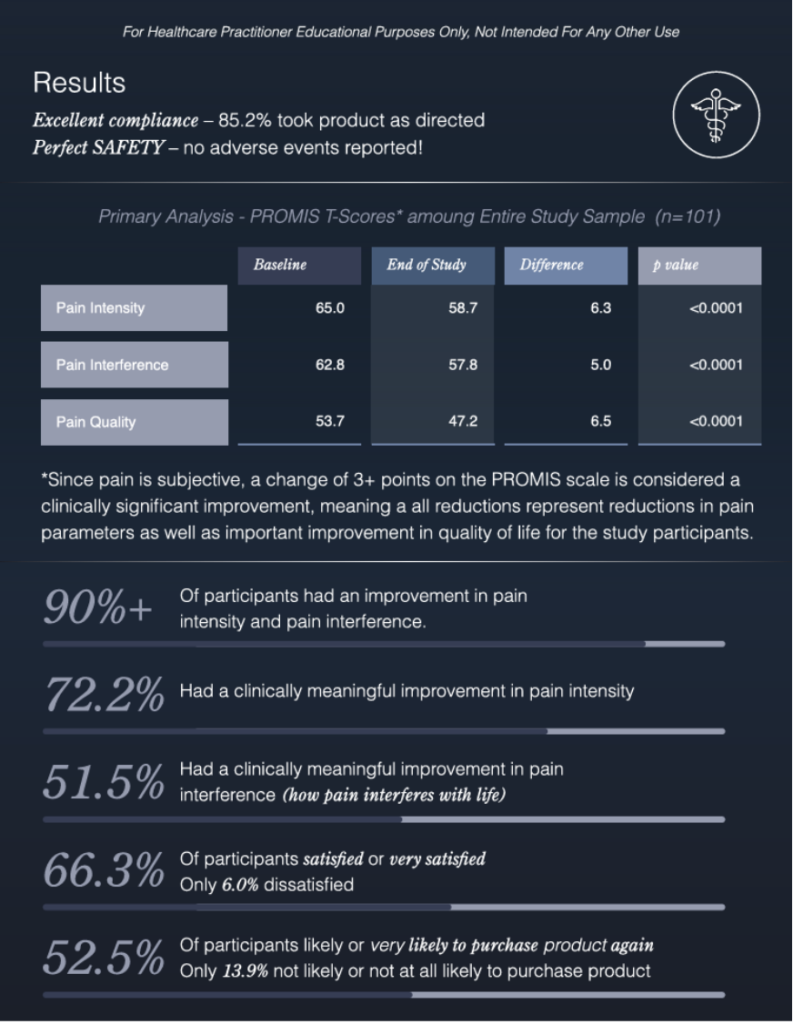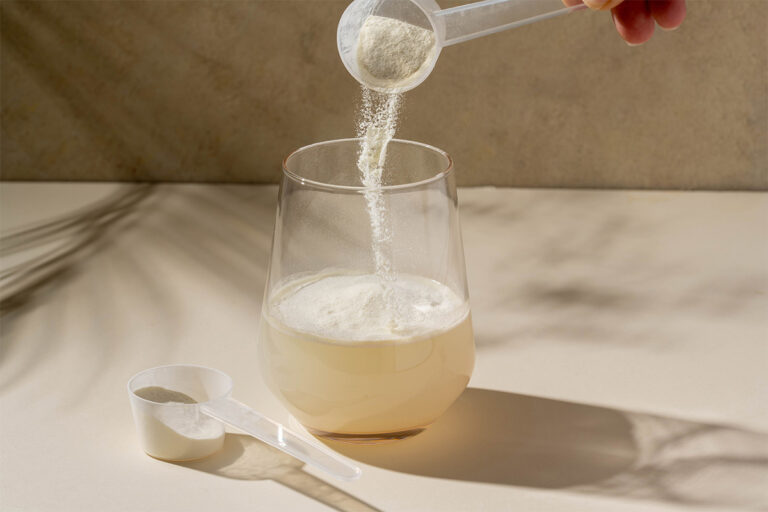BPC-157 is a promising peptide that’s been studied for its potential to protect cells against harmful substances, promote tissue repair, and reduce inflammation. While it has shown promise in animal studies, its safety and efficacy in humans have remained uncertain due to a lack of robust clinical trials. However, a recent human clinical trial has provided new insights into its potential benefits for chronic pain management.
What Is BPC-157?
BPC-157, or Body Protection Compound 157, is a peptide composed of 15 amino acids. Peptides are short chains of amino acids (the “building blocks” of proteins), typically consisting of 2–50 amino acids.
BPC-157 is derived from a naturally occurring protein found in human gastric (stomach) juices that plays a role in protecting and repairing the gastrointestinal (GI) tract. The peptide’s inherent healing capabilities have led scientists to investigate whether BPC-157 could be beneficial beyond the GI tract, particularly in promoting recovery in other types of tissues, including tendons, ligaments, and muscles.
Whole person care is the future.
Fullscript puts it within reach.
Fullscript puts it within reach.
Join 100,000 providers in changing the way
healthcare is delivered.
Benefits of BPC-157
Preliminary studies indicate that BPC-157 exerts its effects through various mechanisms that aid tissue regeneration and repair.
Tissue Repair and Recovery
Research suggests that BPC-157 supports tissue repair and regeneration by activating several biological processes critical for healing and recovery:
- Growth factors: BPC-157 may upregulate growth factors, which are proteins that help control important cell processes like growth and repair by attaching to receptors on cells and triggering signals that guide the cells’ actions.
- Angiogenesis: BPC-157 promotes angiogenesis (the formation of new blood vessels), which supports tissue regeneration by delivering oxygen and nutrients to the cells of the damaged area.
- Nitric oxide: BPC-157 helps control nitric oxide production by activating a specific pathway in the body called the endothelial nitric oxide synthase (eNOS) pathway. Nitric oxide helps dilate blood vessels and improve circulation to injured areas, which can accelerate healing.
- Cell migration: BPC-157 helps stimulate the movement of important cells involved in healing, such as fibroblasts (cells that create connective tissues) and endothelial cells (cells that line the inside of blood vessels).
- Collagen production: BPC-157 boosts the production and improves the organization of collagen, a protein that provides strength and structure to tendons, ligaments, and bones.

Gut Health and Inflammation
BPC-157’s potential extends beyond tissue repair in muscles, tendons, and joints—it may also promote gut health and reduce inflammation.
Beyond the proposed mechanisms involved in tissue healing discussed above, BPC-157 also appears to influence the immune system by modulating inflammatory responses and reducing hallmark signs of inflammation, such as swelling and the recruitment of immune cells to the site of injury. BPC-157 holds potential as an adjunctive therapy to help manage the chronic inflammation characteristic of inflammatory bowel disease.
Taken orally, BPC-157 has demonstrated superior stability and resistance to degradation by the GI tract’s acidic environment. Research suggests that it may help heal ulcers and other forms of GI inflammation induced by factors like alcohol, nonsteroidal anti-inflammatory drugs (NSAIDs), and stress.
The proposed anti-inflammatory properties of BPC-157 are being further researched for their application in the management and treatment of other inflammatory conditions, such as:
Human Clinical Trials
The current evidence and research on BPC-157 are primarily derived from experimental and animal models, which presents limitations when extrapolating these findings to human clinical applications. Most studies have been conducted on small rodent models, and while they have shown promising results in terms of healing and providing protective effects on various tissues, the translation of these outcomes to human physiology remains uncertain.
The first-ever human study on oral BPC-157, published in 2024, represents a step forward in bridging the gap between preclinical research and clinical application. This study provides important insights into its potential role in treating chronic pain.
The study involved 101 participants with moderate to very severe chronic pain, including conditions such as low back pain, osteoarthritis, rheumatoid arthritis, and neuropathic pain, with pain located in areas like the shoulder, back, hip, and knee. The trial lasted four weeks, during which participants received an oral dose of 500 mcg of BPC-157 twice daily.
Results are outlined in the graphic below.

How BPC-157 Fits Into Whole Person Care
While BPC-157 is not FDA-approved for pain management and should be used cautiously, providers may consider its potential benefits as part of a comprehensive treatment plan that includes diet, lifestyle, and complementary therapies.
Diet
Plant-based diets, such as the Mediterranean, vegetarian, and vegan diets, focus on deriving nutrition primarily from plant-based sources. They focus on unprocessed foods rich in anti-inflammatory and antioxidant compounds that can help manage chronic pain.
One scientific review of 17 studies concluded that nutritional interventions aligned with plant-based principles correlated to measurable reductions in inflammatory markers and objective reports of musculoskeletal pain severity.
Incorporating omega-3 fatty acids from sources like fish oil and marine oils has also been shown to benefit patients with chronic pain by reducing inflammation. Clinical studies have demonstrated efficacy in using omega-3 fatty acids to manage chronic pain related to conditions like dysmenorrhea (menstrual cramps), osteoarthritis, rheumatoid arthritis, and fibromyalgia.
A specific dietary guideline proposed by Rondanelli et al. includes a food pyramid for chronic pain management. It recommends daily consumption of low-glycemic-index carbohydrates (three portions), fruits and vegetables (five portions), yogurt (125 mL), red wine (125 mL), and extra-virgin olive oil. Weekly, it suggests legumes and fish (four portions); white meat, eggs, and fresh cheese (two portions); and limited intake of red or processed meats and sweets.
Exercise and Recovery
Regular physical activity has been shown to reduce pain, improve physical function, and enhance quality of life in individuals experiencing various chronic pain conditions, including chronic low back pain, fibromyalgia, and osteoarthritis. The mechanisms underlying these benefits include exercise-induced hypoalgesia (EIH), where pain sensitivity decreases during and after exercise.
Recovery is equally important in chronic pain management. Adequate recovery strategies support muscle regeneration to help prevent symptom flares and ensure a return to homeostatic balance. The optimal recovery time for muscle regeneration post-exercise can range from 24 hours to three days, depending on the condition and exercise type.
Complementary Medicine
According to the National Center for Complementary and Integrative Health, there’s a growing body of evidence to support the incorporation of psychological and physical modalities into the treatment plans for painful conditions, including:
- Acupuncture
- Biofeedback
- Hypnosis
- Massage
- Mindfulness meditation
- Music therapy
- Spinal manipulation
- Tai chi
- Yoga
Final Thoughts
- BPC-157 is a peptide with promising potential for promoting tissue repair and healing, particularly in joint, tendon, and muscle recovery and managing chronic pain syndromes.
- While most research on BPC-157 has been conducted in experimental and animal models, its promising effects on tissue repair, inflammation reduction, and pain management suggest that it could become a valuable tool in clinical settings.
- The recently published human clinical study on oral BPC-157 concluded that BPC-157 was a safe and effective intervention for reducing chronic pain.
- Further research and additional human clinical trials are needed to better understand how BPC-157 translates to human disease management and its long-term safety and efficacy in treating pain and other inflammatory conditions.
Whole person care is the future.
Fullscript puts it within reach.
Fullscript puts it within reach.
Join 100,000 providers in changing the way
healthcare is delivered.
References
- Berardi, G., Eble, C., Hunter, S. K., et al. (2023). Localized Pain and Fatigue During Recovery From Submaximal Resistance Exercise in People With Fibromyalgia. Physical Therapy, 103(6). https://doi.org/10.1093/ptj/pzad033
- Busch, A. J., Webber, S. C., Brachaniec, M., et al. (2011). Exercise Therapy for Fibromyalgia. Current Pain and Headache Reports, 15(5), 358–367. https://doi.org/10.1007/s11916-011-0214-2
- Chang, C.-H., Tsai, W.-C., Hsu, Y.-H., et al. (2014). Pentadecapeptide BPC 157 Enhances the Growth Hormone Receptor Expression in Tendon Fibroblasts. Molecules, 19(11), 19066–19077. https://doi.org/10.3390/molecules191119066
- Chang, C.-H., Tsai, W.-C., Lin, M.-S., et al. (2011). The promoting effect of pentadecapeptide BPC 157 on tendon healing involves tendon outgrowth, cell survival, and cell migration. Journal of Applied Physiology (Bethesda, Md.: 1985), 110(3), 774–780. https://doi.org/10.1152/japplphysiol.00945.2010
- Chronic Pain and Complementary Health Approaches. (2023, January). NCCIH. https://www.nccih.nih.gov/health/chronic-pain-and-complementary-health-approaches-usefulness-and-safety
- Daglis, S. (2024, December 24). BPC 157: Science-Backed Uses, Benefits, Dosage, and Safety. Rupa Health. https://www.rupahealth.com/post/bpc-157-science-backed-uses-benefits-dosage-and-safety
- Fattah, M. A. A., Morsi, S., Fattah, S. A., et al. (2024). High-dose Omega-3 Alters Serum Magnesium and Calcium Levels and Affects Fibromyalgia Symptoms: A Randomized, Double-blind, Placebo-Control Study. Current Rheumatology Reviews, 10.2174/0115733971314334240930043717. https://doi.org/10.2174/0115733971314334240930043717
- Forbes, J., & Krishnamurthy, K. (2023, August 28). Biochemistry, Peptide. PubMed; StatPearls Publishing. https://www.ncbi.nlm.nih.gov/books/NBK562260/
- Gordon, R., & Bloxham, S. (2016). A Systematic Review of the Effects of Exercise and Physical Activity on Non-Specific Chronic Low Back Pain. Healthcare, 4(2), 22. https://doi.org/10.3390/healthcare4020022
- Gwyer, D., Wragg, N. M., & Wilson, S. L. (2019). Gastric pentadecapeptide body protection compound BPC 157 and its role in accelerating musculoskeletal soft tissue healing. Cell and Tissue Research, 377(2), 153–159. https://doi.org/10.1007/s00441-019-03016-8
- Hsieh, M.-J., Lee, C.-H., Chueh, H.-Y., et al. (2020). Modulatory effects of BPC 157 on vasomotor tone and the activation of Src-Caveolin-1-endothelial nitric oxide synthase pathway. Scientific Reports, 10(1). https://doi.org/10.1038/s41598-020-74022-y
- Hsieh, M.-J., Liu, H.-T., Wang, C.-N., et al. (2016). Therapeutic potential of pro-angiogenic BPC157 is associated with VEGFR2 activation and up-regulation. Journal of Molecular Medicine, 95(3), 323–333. https://doi.org/10.1007/s00109-016-1488-y
- Johnson, K. E., & Wilgus, T. A. (2014). Vascular Endothelial Growth Factor and Angiogenesis in the Regulation of Cutaneous Wound Repair. Advances in Wound Care, 3(10), 647–661. https://doi.org/10.1089/wound.2013.0517
- Kalogjera, L., Ries, M., Baudoin, T., et al. (1997). Dose-dependent protective effect of BPC 157 on capsaicin-induced rhinitis in rats. European Archives of Oto-Rhino-Laryngology: Official Journal of the European Federation of Oto-Rhino-Laryngological Societies (EUFOS): Affiliated with the German Society for Oto-Rhino-Laryngology – Head and Neck Surgery, 254 Suppl 1, S9-11. https://doi.org/10.1007/BF02439711
- Kraus, V. B., Sprow, K., Powell, K. E., et al. (2019). Effects of Physical Activity in Knee and Hip Osteoarthritis. Medicine & Science in Sports & Exercise, 51(6), 1324–1339. https://doi.org/10.1249/mss.0000000000001944
- Kremer, J. M., Lawrence, D. A., Petrillo, G. F., et al. (1995). Effects of high-dose fish oil on rheumatoid arthritis after stopping nonsteroidal antiinflammatory drugs. Clinical and immune correlates. Arthritis and Rheumatism, 38(8), 1107–1114. https://doi.org/10.1002/art.1780380813
- Krivic, A., Anic, T., Seiwerth, S., et al. (2006). Achilles Detachment in Rat and Stable Gastric Pentadecapeptide BPC 157: Promoted Tendon-to-Bone Healing and Opposed Corticosteroid Aggravation. Journal of Orthopaedic Research, 24(5), 982–989. https://doi.org/10.1002/jor.20096
- Kuszewski, J. C., Wong, R. H. X., & Howe, P. R. C. (2020). Fish oil supplementation reduces osteoarthritis-specific pain in older adults with overweight/obesity. Rheumatology Advances in Practice, 4(2). https://doi.org/10.1093/rap/rkaa036
- Lee, E., Walker, C., & Ayadi, B. (2024). Effect of BPC-157 on Symptoms in Patients with Interstitial Cystitis: A Pilot Study. Alternative Therapies in Health and Medicine, 30(10), 12–17. https://pubmed.ncbi.nlm.nih.gov/39325560/
- Mendonça, C. R., Noll, M., Castro, M. C. R., et al. (2020). Effects of Nutritional Interventions in the Control of Musculoskeletal Pain: An Integrative Review. Nutrients, 12(10), 3075. https://doi.org/10.3390/nu12103075
- Prego-Dominguez, J., Hadrya, F., & Takkouche, B. (2016). Polyunsaturated Fatty Acids and Chronic Pain: A Systematic Review and Meta-analysis. Pain Physician, 19(8), 521–535. https://pubmed.ncbi.nlm.nih.gov/27906932/
- Rice, D., Nijs, J., Kosek, E., Wideman, T., et al. (2019). Exercise-Induced Hypoalgesia in Pain-Free and Chronic Pain Populations: State of the Art and Future Directions. The Journal of Pain, 20(11), 1249–1266. https://doi.org/10.1016/j.jpain.2019.03.005
- Rondanelli, M., Faliva, M. A., Miccono, A., et al (2018). Food pyramid for subjects with chronic pain: foods and dietary constituents as anti-inflammatory and antioxidant agents. Nutrition Research Reviews, 31(1), 131–151. https://doi.org/10.1017/s0954422417000270
- Seiwerth, S., Milavić, M., Vukojević, J., et al. (2021). Stable Gastric Pentadecapeptide BPC 157 and Wound Healing. Frontiers in Pharmacology, 12. https://doi.org/10.3389/fphar.2021.627533
- Sikiric, P., Gojkovic, S., Krezic, I., et al. (2023). Stable Gastric Pentadecapeptide BPC 157 May Recover Brain–Gut Axis and Gut–Brain Axis Function. Pharmaceuticals (Basel), 16(5), 676–676. https://doi.org/10.3390/ph16050676
- Sikiric, P., Seiwerth, S., Grabarevic, Z., et al. (1997). Pentadecapeptide BPC 157 positively affects both non-steroidal anti-inflammatory agent-induced gastrointestinal lesions and adjuvant arthritis in rats. Journal of Physiology-Paris, 91(3-5), 113–122. https://doi.org/10.1016/s0928-4257(97)89474-0
- Sikirić, P., Seiwerth, S., Grabarević, Ž., et al. (1996). Salutary and prophylactic effect of pentadecapeptide BPC 157 on acute pancreatitis and concomitant gastroduodenal lesions in rats. Digestive Diseases and Sciences, 41(7), 1518–1526. https://doi.org/10.1007/bf02088582
- Sikiric, P., Seiwerth, S., Rucman, R., et al. (2011). Stable gastric pentadecapeptide BPC 157: novel therapy in gastrointestinal tract. Current Pharmaceutical Design, 17(16), 1612–1632. https://doi.org/10.2174/138161211796196954
- Stanford, J. (2024, February 20). The Science Behind Anti-Inflammatory Eating: What Does Research Say? Rupa Health. https://www.rupahealth.com/post/the-science-behind-anti-inflammatory-eating-what-does-research-say
- Stone, W. L., Leavitt, L., & Varacallo, M. A. (2023, May 1). Physiology, Growth Factor. PubMed; StatPearls Publishing. https://www.ncbi.nlm.nih.gov/books/NBK442024/
- Vukojević, J., Milavić, M., Perović, D., et al. (2022). Pentadecapeptide BPC 157 and the central nervous system. Neural Regeneration Research, 17(3), 482–482. https://doi.org/10.4103/1673-5374.320969
- Vukojević, J., Vrdoljak, B., Malekinušić, D., et al. (2020). The effect of pentadecapeptide BPC 157 on hippocampal ischemia/reperfusion injuries in rats. Brain and Behavior, 10(8). https://doi.org/10.1002/brb3.1726
- Vuksic, T., Zoricic, I., Brcic, L., et al. (2007). Stable Gastric Pentadecapeptide BPC 157 in Trials for Inflammatory Bowel Disease (PL-10, PLD-116, PL14736, Pliva, Croatia) Heals Ileoileal Anastomosis in the Rat. Surgery Today, 37(9), 768–777. https://doi.org/10.1007/s00595-006-3498-9
- Weinberg, J. L. (2024, January 2). Impact of Plant-Based Diets on Chronic Inflammation Reduction. Rupa Health. https://www.rupahealth.com/post/impact-of-plant-based-diets-on-chronic-inflammation-reduction
- Winter, K. (2023, November 27). Maximizing Muscle Recovery: The Role of Post-Workout Nutrition. Rupa Health. https://www.rupahealth.com/post/maximizing-muscle-recovery-the-role-of-post-workout-nutrition
- Witte, M. B., & Barbul, A. (2002). Role of nitric oxide in wound repair. The American Journal of Surgery, 183(4), 406–412. https://doi.org/10.1016/s0002-9610(02)00815-2
- Yoshimura, H. (2024, April 8). Evidence-Based Review: The Role of Anti-Inflammatory Foods. Rupa Health. https://www.rupahealth.com/post/evidence-based-review-the-role-of-anti-inflammatory-foods





